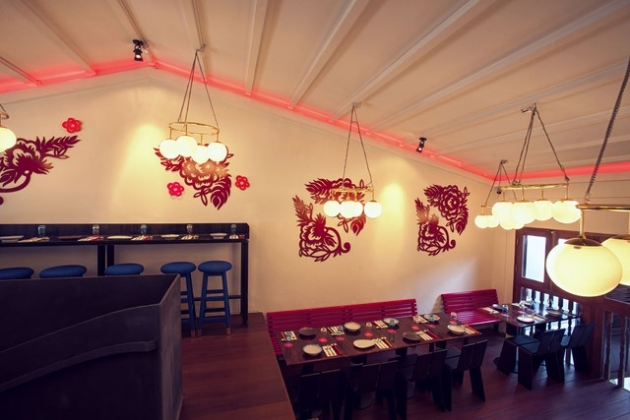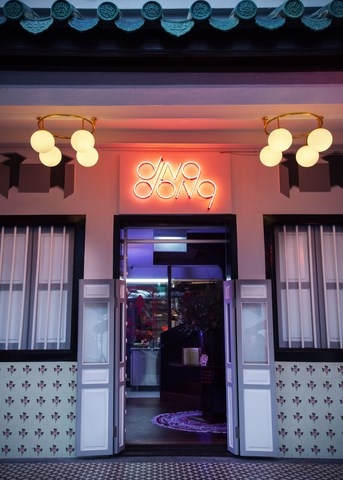About Ding Dong
Update: Ding Dong will move to 115 Amoy Street on Monday, 20 June 2016. Their last day at 23 Ann Siang Road will be on Friday, 3 June 2016.
Perched on the far end of the hip Ann Siang Road is Ding Dong, a restaurant helmed by Ryan Clift from Tippling Club, which specialises in Southeast Asian flavours with a modern twist. We entered and made our way up the three storey shophouse and were greeted by the kitchen on the first floor, hidden behind glass doors and Peranakan-style mosaic tiles.
We entered the dining space on the third floor, while passing by the bar on the second. The modern take on Chinese retro decor and neon lights made for a unique dining concept.
Even though Ding Dong has been around for a while now, Head Chef Jet Lo has only recently stepped in to change 70% of the menu to inject a Peranakan flair into the dishes. Having obtained a higher diploma in Culinary Studies in Switzerland, it’s no surprise that a lot of his inspiration comes from European cuisine. But he reveals that he still retains his Peranakan roots in his cooking. A quick glance at the menu shows a lot of that.
The Cold Plates at Ding Dong
We started off with the cold dishes. The Homemade Black Miso Tofu, Daikon and Ginger Salad with Japanese dressing was one with a lot of emphasis on the juxtaposing flavours and textures from the sweet and sour flavours to the slight graininess of the tofu and the crunchy daikon. It was very appetising and a great start to the lunch.
The second cold dish, an Asian Wagyu Beef Tartare with homemade chilli sauce and pickled vegetables, was served alongside papadum. Having beef tartare is quite new to me since I’m not into raw minced beef. I thought that the papadum and tartare combination went quite well together.
It was like their version of cheese and crackers, done Peranakan fusion style. The chilli and pickled vegetables gave the tartare that Southeast Asian flair, but I thought that it had too many strong flavours going on in the dish and I couldn’t really taste the beef.
The Small Plates at Ding Dong
The first small plate dish we had was the Roasted Duck Dumpling, Shiitake Mushroom and Duck Consommé. The dumplings were juicy and went very well with the sweet sauce and vinegar. I haven’t had a duck dumpling before, but it tasted like something I could find in a Chinese restaurant. Delicious, but slightly underwhelming.
I really liked the Carbon-battered Prawn Tempura served with red curry marinade and soy wasabi mayonnaise, even though my lunch partner found it quite plain. Something about the batter was definitely done right. It was distinctly different from other prawn tempuras that we’ve had before, and I’m not just talking about the colour. The light batter coated the prawn very well and didn’t leave a greasy aftertaste.
Next up, we had the Crispy Pig Ears with Sichuan peppers and lime. It was served in a brown paper bag with a chopstick and lime. We squeezed the lime in, as we would for our BBQ chicken wings and Hokkien mee.
This one was surprisingly addictive, though I have to admit that I was a little put off when I first heard it. Like the beef tartare, eating pig ears is definitely a first for me. They came in curly shreds, which made it so easy for me to pop a shred after another into my mouth. But it can get a little too heaty, so I reckon this would go very well with beer.
We also tried the Ding Dong Blue Lobster Bao. It’s like your kong bak bao, but instead of the bak or meat, it’s lobster. This luxurious twist to a classic Chinese bao dish was served with hoisin, cucumber and crispy shallots. The lobster was really fresh and had a lovely bounce to the meat, but it didn’t go that well with the bun.
Braised pork would still have been a better meat choice for the bao, because of how it melts into the bun. The blue lobster didn’t do that for me, which was a bit of a letdown. I’d rather have the lobster on its own actually.
For the last of the small plates, we had the Homemade Pancake with Spiced Minced Pork and Kaffir Lime Yoghurt. That was definitely my favourite among all the small plates. Apparently it’s the chef’s favourite as well. The spice of the minced pork was a little too much for me at first, but it was nicely balanced by the kaffir lime yoghurt. I’d definitely order this again the next time I’m here.
The Bigger Plates at Ding Dong
Finally, we’re on to the mains. We had the Assam Pedas with Saltwater Barramundi which we both loved. The Peranakan dish was served with okra, or more commonly known as ladies’ finger, and eggplant. The skin was crisp even after the fresh fish was soaked in the curry.
I hear it’s one of the best-sellers since the launch of the new menus, and I’m not surprised. The curry was very good drizzled over rice, but the strong flavours might have overpowered the taste of the fresh fish. A hearty and enjoyable dish to share, nonetheless.
The 48 hour Beef Cheek Rendang was not to be dismissed either. In fact, I thought it was the star of the meal. Beef cheeks cooked in rendang paste for 48 hours? Yes please. Unlike the usual rendang that we usually have, this one was slightly orangey in colour but no less delicious.
The rice puree and crispy herbs were unexpected additions to the classic dish, and was delightful when eaten with rice. The meat was so tender that it sliced off nicely and we couldn’t help but to keep going back for more. This is without doubt the best beef rendang I’ve had in a long while.
The Desserts at Ding Dong
The desserts were definitely the some of the most innovative ones I’ve come across. Most of them looked like they were something out of Masterchef, with dry ice tricks and its likes.
Ding Dong’s Frozen Bibimbap came out tops on the creativity charts. Their interpretation of the Korean dish for their dessert menu was quite mind-boggling. They stayed true to the colours of the bibimbap and used puffed rice, cucumber meringue, chilli cherry compote and mango sorbet sphere, but it tasted nothing like the bibimbap that we are used to eating.
While I liked the different elements in this dessert, I didn’t fancy the chilli cherry compote. The spice didn’t seem to go that well with the other airy and icy elements.
My favourite would have to be the Gula Melaka with Sago Pudding and Coconut. This dessert is a close second on the creativity charts. The dehydrated gula melaka meringue was served with popcorn, coconut ice cream, sago pudding and coconut powder. I couldn’t keep my fork off the gula melaka meringue because, after all, it’s such a local flavour in the form of one of my favourite sweet treats.
The coconut ice cream was rich without being too cloyingly sweet, which I appreciated. The lightly salted popcorn was there to balance the sweetness of the dessert, but I thought that it could have done without it. But it was a nice touch to the dessert anyway.
Even though I didn’t like the chilli cherry compote from the frozen bibimbap much, one spiced dessert that stood out for me was the Asian Spiced Gluten-free Cake. The hints of spice really complemented the chocolate cake while the tamarind sorbet and roselle gel gave the dessert a slight tanginess to the otherwise boring chocolate cake.
The Textures of Chocolate and Kaya is another Peranakan-inspired dessert, and we hear it’s a hit among diners. It was innovative to plate several textures of chocolate with kaya mousse. While interesting, I thought that this was rather forgettable compared to the other desserts on the menu.
Our Verdict
The thought and innovation put in the dishes were amazing. The fusion of cultures in the dishes was very apparent, especially in the desserts. I thought that some of the small plate dishes were unique, but not memorable. But I loved the bigger plates because the classic dishes were brought up a notch.
If you’re undecided about what to have, you can choose the “Sharing” Menu at $55++/pax without dessert and $67++/pax with dessert. The chef will select dishes for you and your group to share. We had the sharing plates, which was great, because we got to try a variety of dishes. Alternatively, you can opt for the “Tasting Menu”, where the chef will prepare six individually plated courses. This option will set you back by $80++/pax.
That’s a hefty price to pay, if you ask me. I wonder if Singaporeans are willing to pay a premium price for modern interpretations of dishes which are rather close to our hearts. That being said, I might come back for an occasion with the family if I’m willing to splurge. I’m pretty sure the Southeast Asian flavours will go down very well with the older folks as well.
Getting to Ding Dong
Address: 23 Ann Siang Road, Singapore 069703
Telephone: 6557 0189
Facebook: https://www.facebook.com/dingdongsingapore
Website: http://www.dingdong.com.sg/
This post was brought to you by Ding Dong.

